Abstract
We tested the hypothesis that intracellular Ca++ [( Ca++]i) overload underlies the diastolic dysfunction of patients with hypertrophic cardiomyopathy. Myocardial tissue was obtained at the time of surgery or transplantation from patients with hypertrophic cardiomyopathy and was compared with control myocardium obtained from patients without heart disease. The isometric contractions and electrophysiologic properties of all myocardial specimens were recorded by standard techniques and [Ca++]i was measured with the bioluminescent calcium indicator aequorin. In contrast to the controls, action potentials, Ca++ transients, and isometric contraction and relaxation were markedly prolonged in the hypertrophic myocardium, and the Ca++ transients consisted of two distinct components. At 38 degrees C and 1 Hz pacing frequency, a state of relative Ca++ overload appeared develop, which produced a rise in end-diastolic [Ca++]i, incomplete relaxation, and fusion of twitches with a resultant decrease in active tension development. We also found that drugs with increase [Ca++]i, such as digitalis, exacerbated these abnormalities, whereas drugs that lower [Ca++]i, such as verapamil, or agents that increase cyclic AMP, such as forskolin, prevented them. These results may explain why patients with hypertrophic cardiomyopathy tolerate tachycardia poorly, and may have important implications with regard to the pharmacologic treatment of patients with hypertrophic cardiomyopathy.
Full text
PDF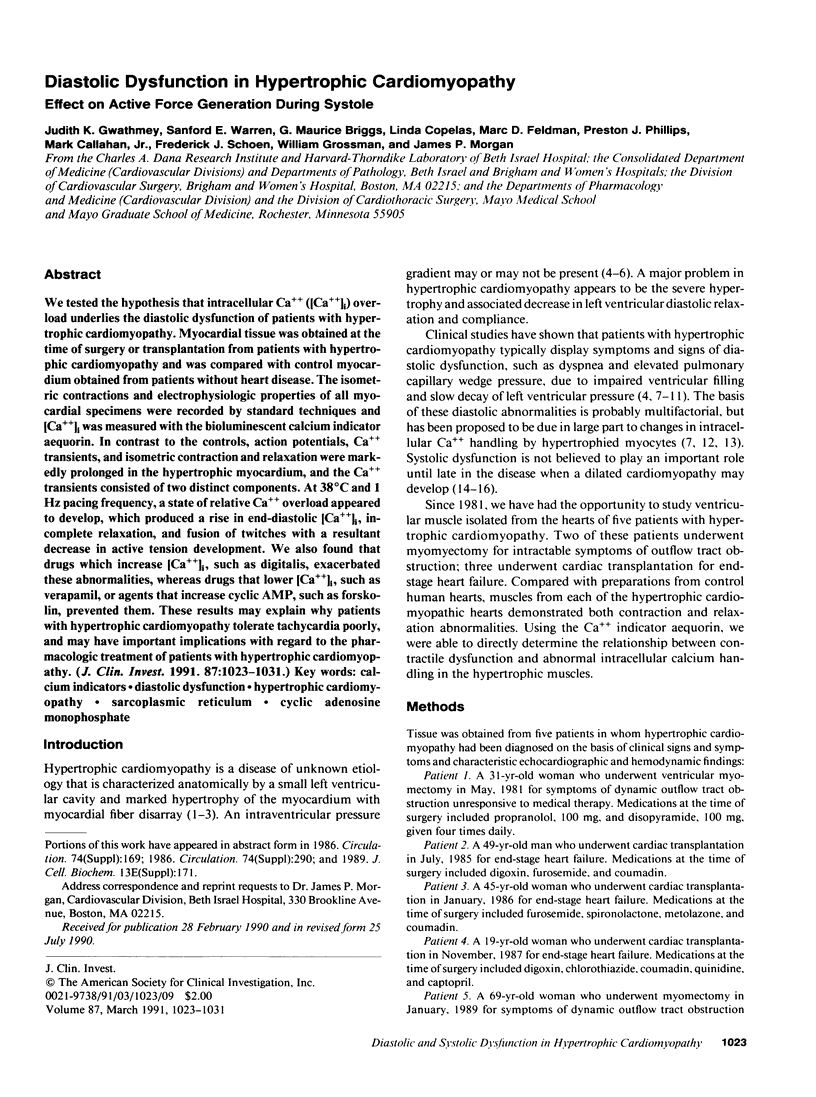
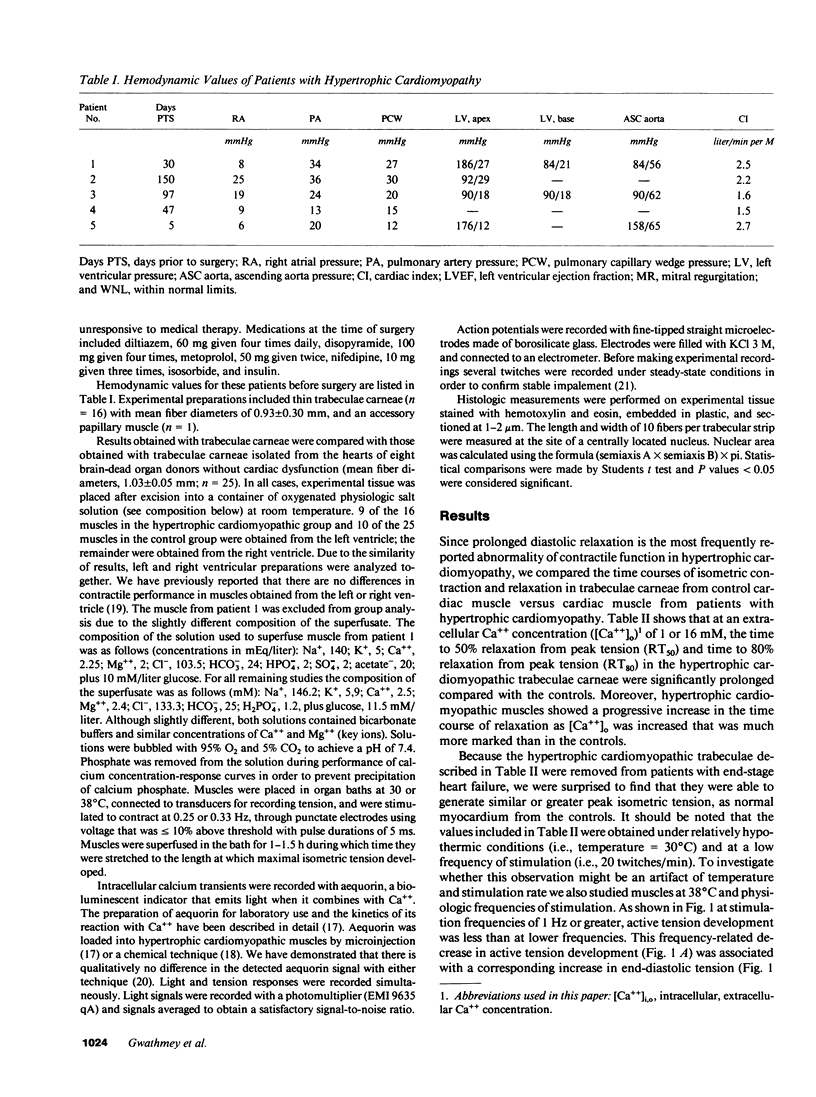
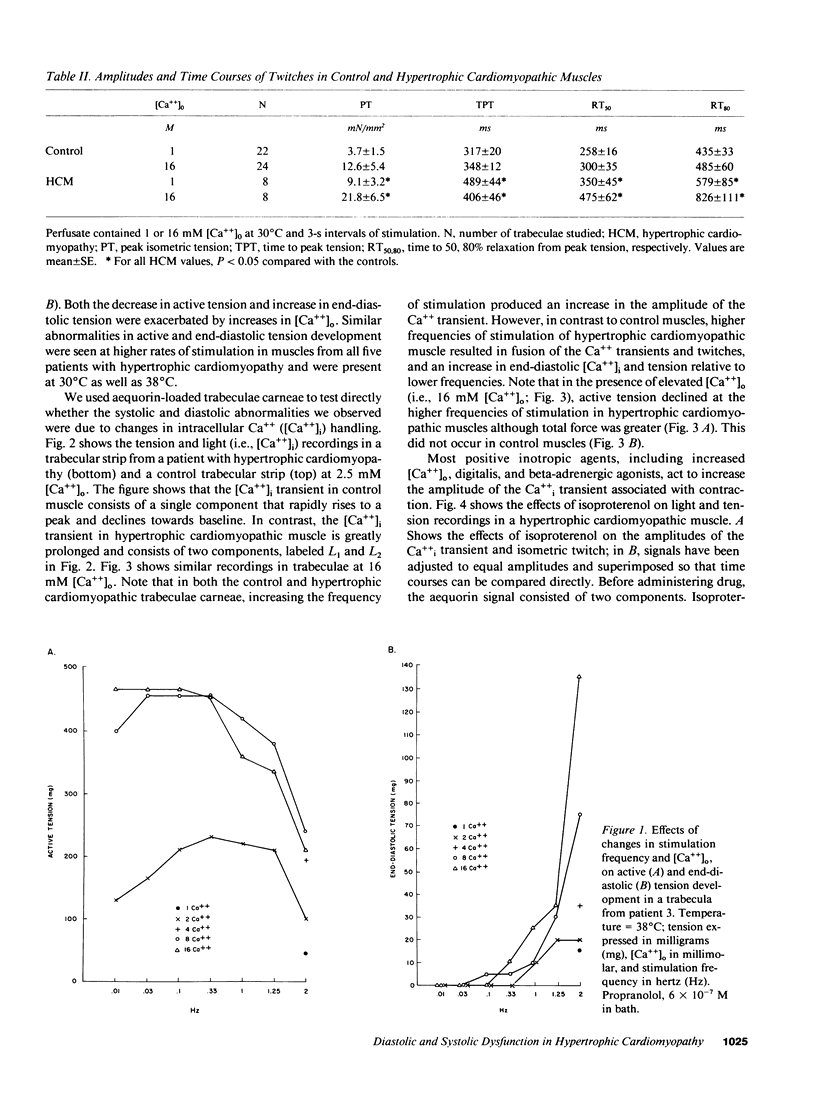
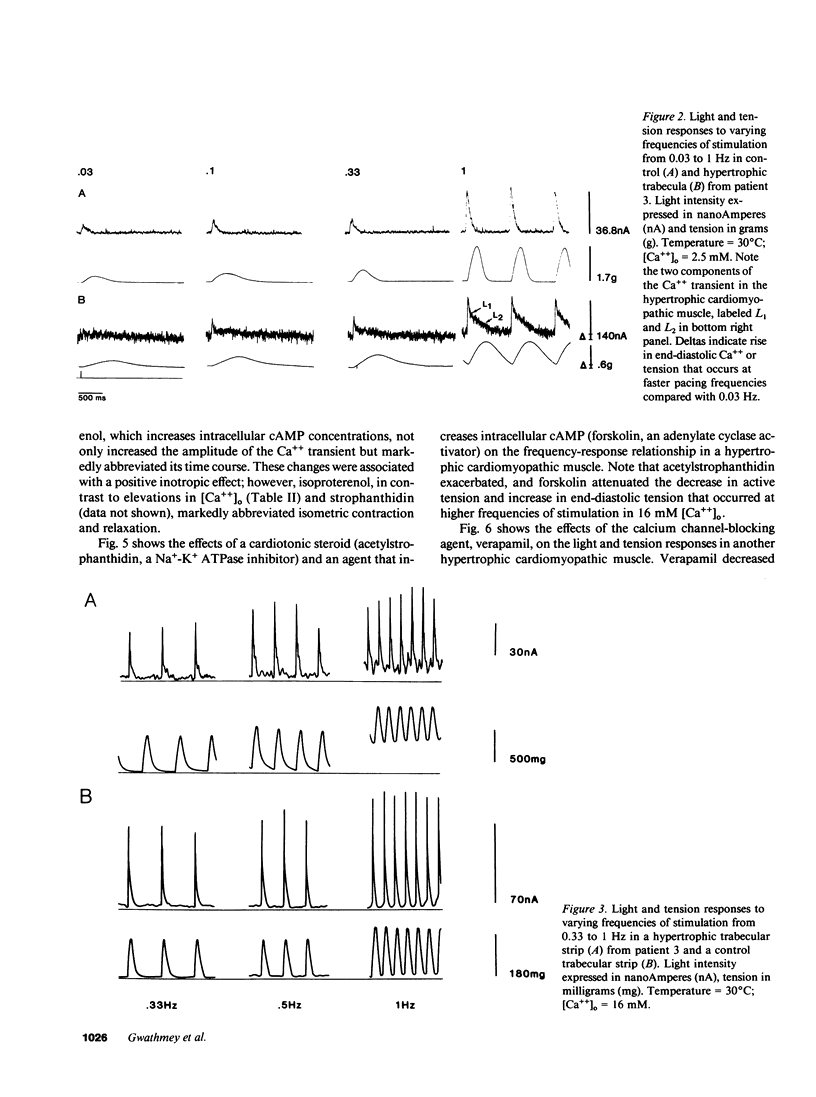
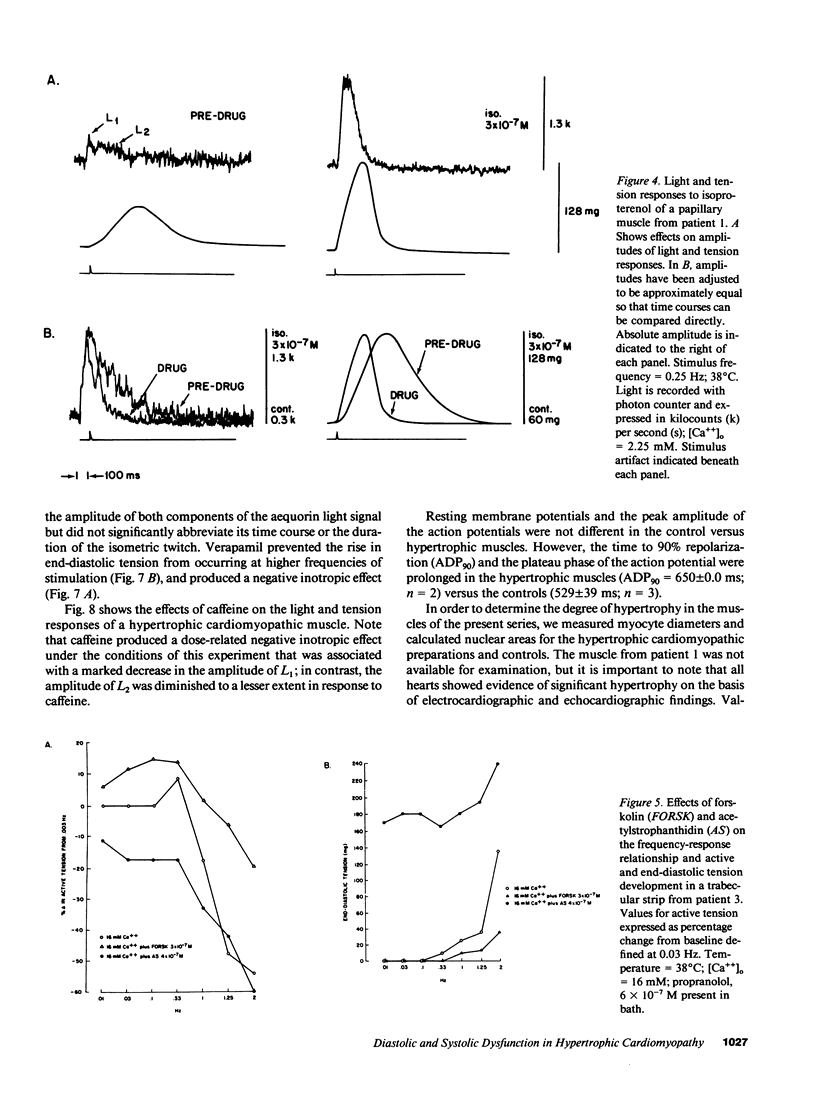
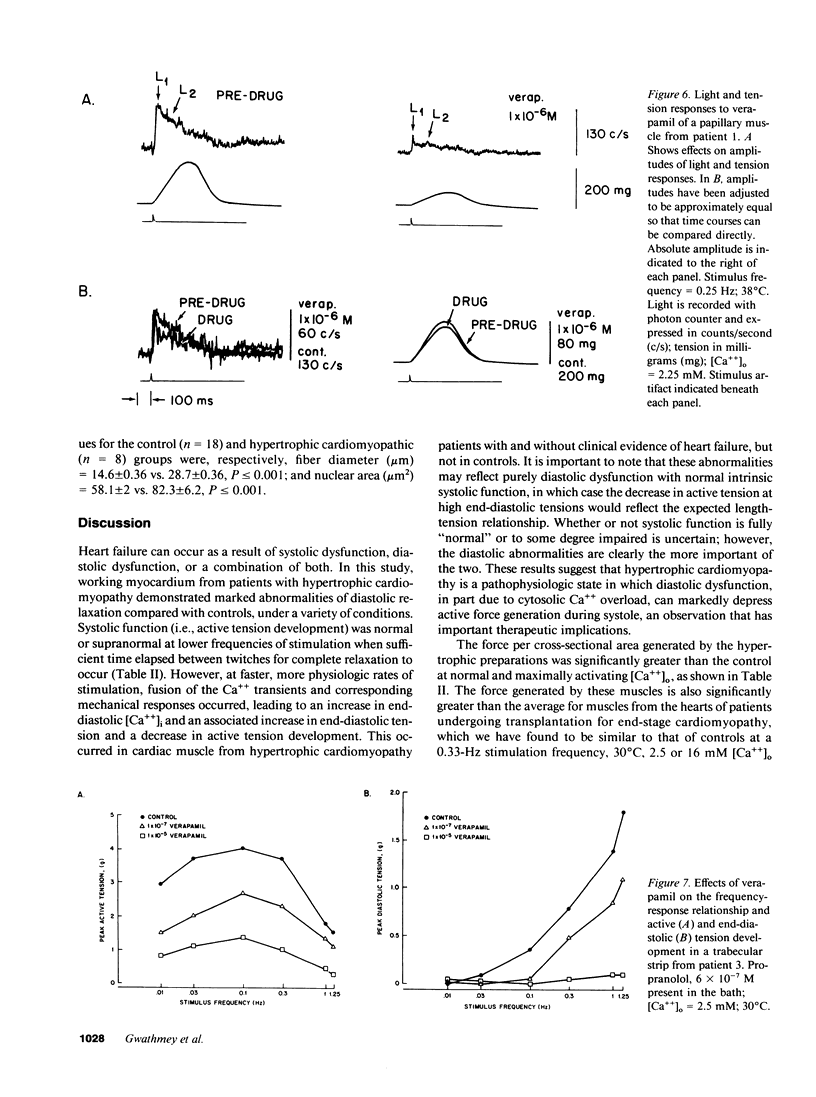
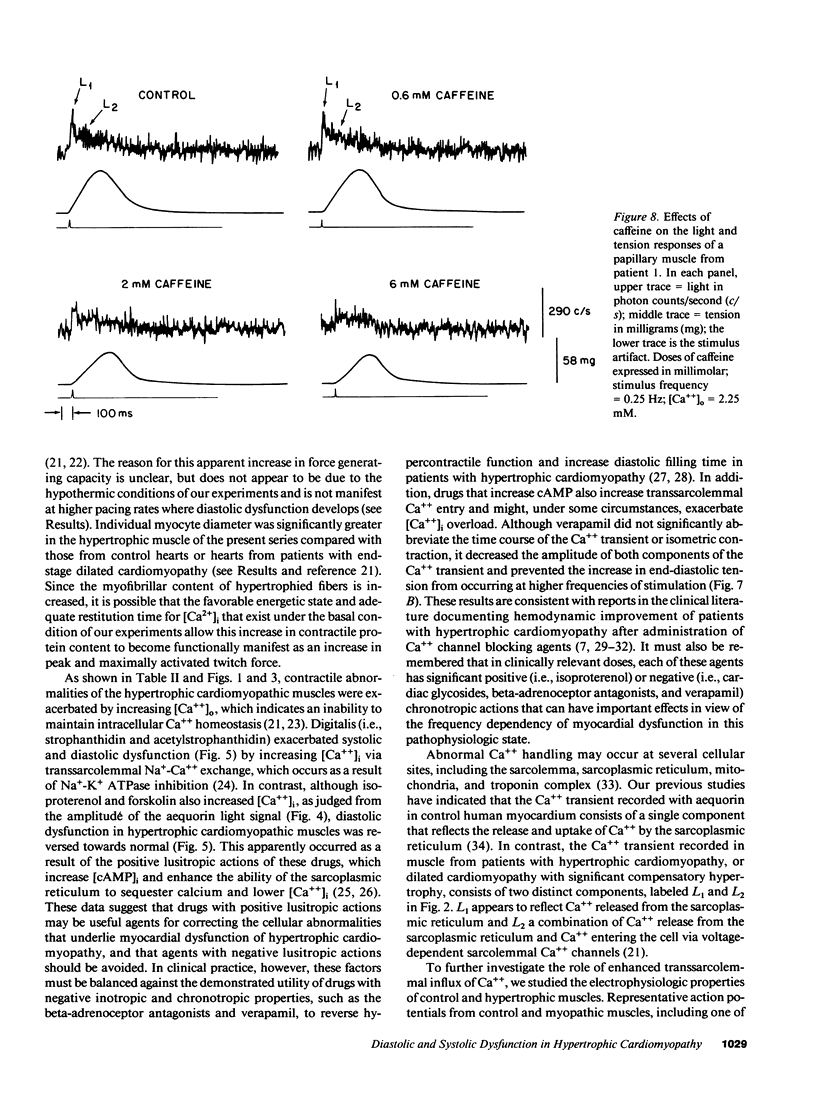
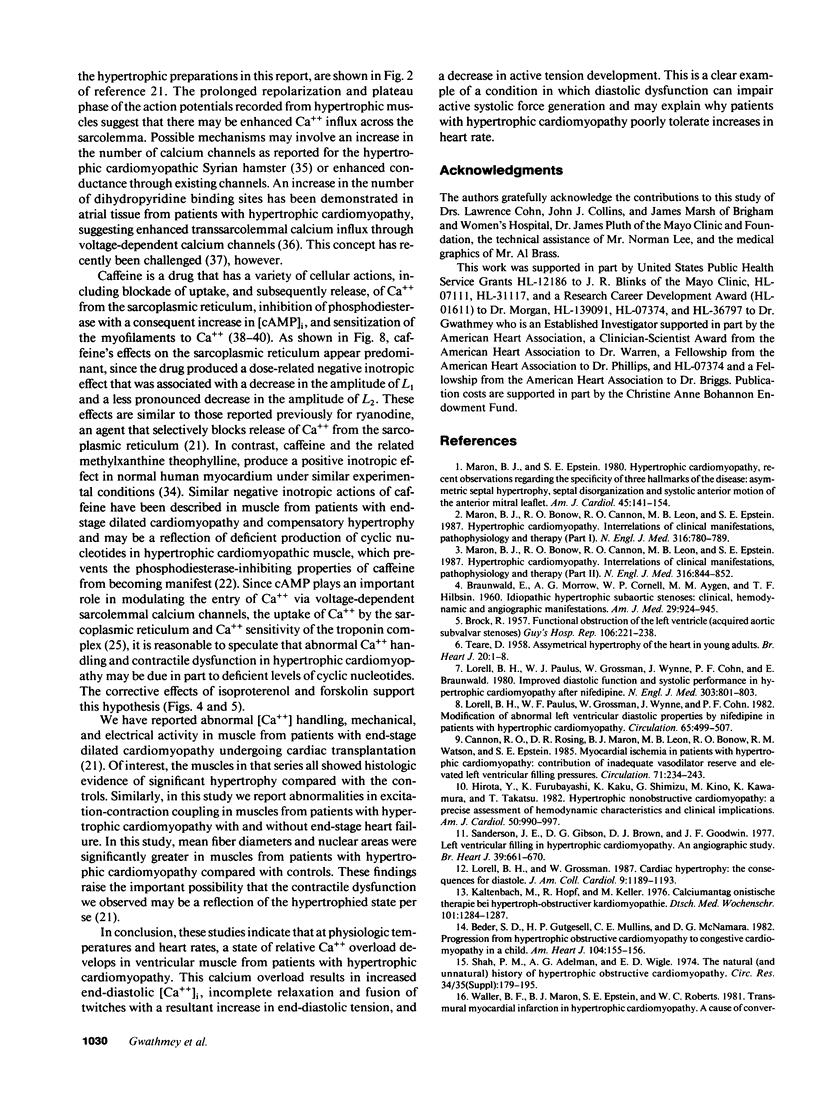
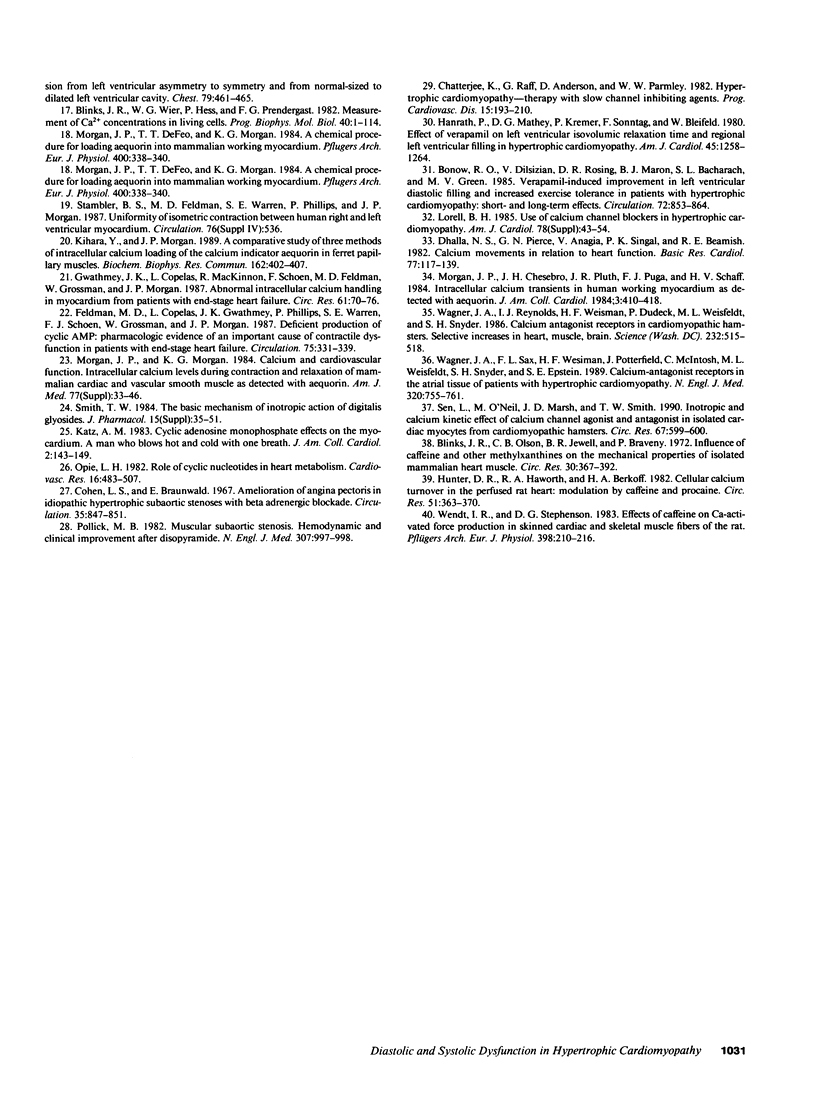
Selected References
These references are in PubMed. This may not be the complete list of references from this article.
- BROCK R. Functional obstruction of the left ventricle; acquired aortic subvalvar stenosis. Guys Hosp Rep. 1957;106(4):221–238. [PubMed] [Google Scholar]
- Beder S. D., Gutgesell H. P., Mullins C. E., McNamara D. G. Progression from hypertrophic obstructive cardiomyopathy to congestive cardiomyopathy in a child. Am Heart J. 1982 Jul;104(1):155–156. doi: 10.1016/0002-8703(82)90654-8. [DOI] [PubMed] [Google Scholar]
- Blinks J. R., Olson C. B., Jewell B. R., Bravený P. Influence of caffeine and other methylxanthines on mechanical properties of isolated mammalian heart muscle. Evidence for a dual mechanism of action. Circ Res. 1972 Apr;30(4):367–392. doi: 10.1161/01.res.30.4.367. [DOI] [PubMed] [Google Scholar]
- Blinks J. R., Wier W. G., Hess P., Prendergast F. G. Measurement of Ca2+ concentrations in living cells. Prog Biophys Mol Biol. 1982;40(1-2):1–114. doi: 10.1016/0079-6107(82)90011-6. [DOI] [PubMed] [Google Scholar]
- Bonow R. O., Dilsizian V., Rosing D. R., Maron B. J., Bacharach S. L., Green M. V. Verapamil-induced improvement in left ventricular diastolic filling and increased exercise tolerance in patients with hypertrophic cardiomyopathy: short- and long-term effects. Circulation. 1985 Oct;72(4):853–864. doi: 10.1161/01.cir.72.4.853. [DOI] [PubMed] [Google Scholar]
- Cannon R. O., 3rd, Rosing D. R., Maron B. J., Leon M. B., Bonow R. O., Watson R. M., Epstein S. E. Myocardial ischemia in patients with hypertrophic cardiomyopathy: contribution of inadequate vasodilator reserve and elevated left ventricular filling pressures. Circulation. 1985 Feb;71(2):234–243. doi: 10.1161/01.cir.71.2.234. [DOI] [PubMed] [Google Scholar]
- Chatterjee K., Raff G., Anderson D., Parmley W. W. Hypertrophic cardiomyopathy--therapy with slow channel inhibiting agents. Prog Cardiovasc Dis. 1982 Nov-Dec;25(3):193–210. doi: 10.1016/0033-0620(82)90016-0. [DOI] [PubMed] [Google Scholar]
- Cohen L. S., Braunwald E. Amelioration of angina pectoris in idiopathic hypertrophic subaortic stenosis with beta-adrenergic blockade. Circulation. 1967 May;35(5):847–851. doi: 10.1161/01.cir.35.5.847. [DOI] [PubMed] [Google Scholar]
- Dhalla N. S., Pierce G. N., Panagia V., Singal P. K., Beamish R. E. Calcium movements in relation to heart function. Basic Res Cardiol. 1982 Mar-Apr;77(2):117–139. doi: 10.1007/BF01908167. [DOI] [PubMed] [Google Scholar]
- Feldman M. D., Copelas L., Gwathmey J. K., Phillips P., Warren S. E., Schoen F. J., Grossman W., Morgan J. P. Deficient production of cyclic AMP: pharmacologic evidence of an important cause of contractile dysfunction in patients with end-stage heart failure. Circulation. 1987 Feb;75(2):331–339. doi: 10.1161/01.cir.75.2.331. [DOI] [PubMed] [Google Scholar]
- Gwathmey J. K., Copelas L., MacKinnon R., Schoen F. J., Feldman M. D., Grossman W., Morgan J. P. Abnormal intracellular calcium handling in myocardium from patients with end-stage heart failure. Circ Res. 1987 Jul;61(1):70–76. doi: 10.1161/01.res.61.1.70. [DOI] [PubMed] [Google Scholar]
- Hanrath P., Mathey D. G., Kremer P., Sonntag F., Bleifeld W. Effect of verapamil on left ventricular isovolumic relaxation time and regional left ventricular filling in hypertrophic cardiomyopathy. Am J Cardiol. 1980 Jun;45(6):1258–1264. doi: 10.1016/0002-9149(80)90487-7. [DOI] [PubMed] [Google Scholar]
- Hirota Y., Furubayashi K., Kaku K., Shimizu G., Kino M., Kawamura K., Takatsu T. Hypertrophic nonobstructive cardiomyopathy: a precise assessment of hemodynamic characteristics and clinical implications. Am J Cardiol. 1982 Nov;50(5):990–997. doi: 10.1016/0002-9149(82)90407-6. [DOI] [PubMed] [Google Scholar]
- Hunter D. R., Haworth R. A., Berkoff H. A. Cellular calcium turnover in the perfused rat heart: modulation by caffeine and procaine. Circ Res. 1982 Sep;51(3):363–370. doi: 10.1161/01.res.51.3.363. [DOI] [PubMed] [Google Scholar]
- Kaltenbach M., Hopf R., Keller M. Calciumantagonistische Therapie bei hypertroph-obstruktiver Kardiomyopathie. Dtsch Med Wochenschr. 1976 Aug 27;101(35):1284–1287. doi: 10.1055/s-0028-1104257. [DOI] [PubMed] [Google Scholar]
- Katz A. M. Cyclic adenosine monophosphate effects on the myocardium: a man who blows hot and cold with one breath. J Am Coll Cardiol. 1983 Jul;2(1):143–149. doi: 10.1016/s0735-1097(83)80387-8. [DOI] [PubMed] [Google Scholar]
- Kihara Y., Morgan J. P. A comparative study of three methods for intracellular loading of the calcium indicator aequorin in ferret papillary muscles. Biochem Biophys Res Commun. 1989 Jul 14;162(1):402–407. doi: 10.1016/0006-291x(89)92011-1. [DOI] [PubMed] [Google Scholar]
- Lorell B. H., Grossman W. Cardiac hypertrophy: the consequences for diastole. J Am Coll Cardiol. 1987 May;9(5):1189–1193. doi: 10.1016/s0735-1097(87)80326-1. [DOI] [PubMed] [Google Scholar]
- Lorell B. H., Paulus W. J., Grossman W., Wynne J., Cohn P. F., Braunwald E. Improved diastolic function and systolic performance in hypertrophic cardiomyopathy after nifedipine. N Engl J Med. 1980 Oct 2;303(14):801–803. doi: 10.1056/NEJM198010023031407. [DOI] [PubMed] [Google Scholar]
- Lorell B. H., Paulus W. J., Grossman W., Wynne J., Cohn P. F. Modification of abnormal left ventricular diastolic properties by nifedipine in patients with hypertrophic cardiomyopathy. Circulation. 1982 Mar;65(3):499–507. doi: 10.1161/01.cir.65.3.499. [DOI] [PubMed] [Google Scholar]
- Lorell B. H. Use of calcium channel blockers in hypertrophic cardiomyopathy. Am J Med. 1985 Feb 22;78(2B):43–54. doi: 10.1016/0002-9343(85)90169-x. [DOI] [PubMed] [Google Scholar]
- Maron B. J., Bonow R. O., Cannon R. O., 3rd, Leon M. B., Epstein S. E. Hypertrophic cardiomyopathy. Interrelations of clinical manifestations, pathophysiology, and therapy (1). N Engl J Med. 1987 Mar 26;316(13):780–789. doi: 10.1056/NEJM198703263161305. [DOI] [PubMed] [Google Scholar]
- Maron B. J., Bonow R. O., Cannon R. O., 3rd, Leon M. B., Epstein S. E. Hypertrophic cardiomyopathy. Interrelations of clinical manifestations, pathophysiology, and therapy (2). N Engl J Med. 1987 Apr 2;316(14):844–852. doi: 10.1056/NEJM198704023161405. [DOI] [PubMed] [Google Scholar]
- Maron B. J., Epstein S. E. Hypertrophic cardiomyopathy. Recent observations regarding the specificity of three hallmarks of the disease: asymmetric septal hypertrophy, septal disorganization and systolic anterior motion of the anterior mitral leaflet. Am J Cardiol. 1980 Jan;45(1):141–154. doi: 10.1016/0002-9149(80)90232-5. [DOI] [PubMed] [Google Scholar]
- Morgan J. P., Chesebro J. H., Pluth J. R., Puga F. J., Schaff H. V. Intracellular calcium transients in human working myocardium as detected with aequorin. J Am Coll Cardiol. 1984 Feb;3(2 Pt 1):410–418. doi: 10.1016/s0735-1097(84)80028-5. [DOI] [PubMed] [Google Scholar]
- Morgan J. P., DeFeo T. T., Morgan K. G. A chemical procedure for loading the calcium indicator acquorin into mammalian working myocardium. Pflugers Arch. 1984 Mar;400(3):338–340. doi: 10.1007/BF00581571. [DOI] [PubMed] [Google Scholar]
- Morgan J. P., Morgan K. G. Calcium and cardiovascular function. Intracellular calcium levels during contraction and relaxation of mammalian cardiac and vascular smooth muscle as detected with aequorin. Am J Med. 1984 Nov 5;77(5A):33–46. doi: 10.1016/s0002-9343(84)80006-6. [DOI] [PubMed] [Google Scholar]
- Opie L. H. Role of cyclic nucleotides in heart metabolism. Cardiovasc Res. 1982 Sep;16(9):483–507. doi: 10.1093/cvr/16.9.483. [DOI] [PubMed] [Google Scholar]
- Pollick C. Muscular subaortic stenosis: hemodynamic and clinical improvement after disopyramide. N Engl J Med. 1982 Oct 14;307(16):997–999. doi: 10.1056/NEJM198210143071607. [DOI] [PubMed] [Google Scholar]
- Sanderson J. E., Gibson D. G., Brown D. J., Goodwin J. F. Left ventricular filling in hypertrophic cardiomyopathy. An angiographic study. Br Heart J. 1977 Jun;39(6):661–670. doi: 10.1136/hrt.39.6.661. [DOI] [PMC free article] [PubMed] [Google Scholar]
- Sen L. Y., O'Neill M., Marsh J. D., Smith T. W. Inotropic and calcium kinetic effects of calcium channel agonist and antagonist in isolated cardiac myocytes from cardiomyopathic hamsters. Circ Res. 1990 Sep;67(3):599–608. doi: 10.1161/01.res.67.3.599. [DOI] [PubMed] [Google Scholar]
- Smith T. W. The basic mechanism of inotropic action of digitalis glycosides. J Pharmacol. 1984;15 (Suppl 1):35–51. [PubMed] [Google Scholar]
- TEARE D. Asymmetrical hypertrophy of the heart in young adults. Br Heart J. 1958 Jan;20(1):1–8. doi: 10.1136/hrt.20.1.1. [DOI] [PMC free article] [PubMed] [Google Scholar]
- Wagner J. A., Reynolds I. J., Weisman H. F., Dudeck P., Weisfeldt M. L., Snyder S. H. Calcium antagonist receptors in cardiomyopathic hamster: selective increases in heart, muscle, brain. Science. 1986 Apr 25;232(4749):515–518. doi: 10.1126/science.3008330. [DOI] [PubMed] [Google Scholar]
- Wagner J. A., Sax F. L., Weisman H. F., Porterfield J., McIntosh C., Weisfeldt M. L., Snyder S. H., Epstein S. E. Calcium-antagonist receptors in the atrial tissue of patients with hypertrophic cardiomyopathy. N Engl J Med. 1989 Mar 23;320(12):755–761. doi: 10.1056/NEJM198903233201202. [DOI] [PubMed] [Google Scholar]
- Waller B. F., Maron B. J., Epstein S. E., Roberts W. C. Transmural myocardial infarction in hypertrophic cardiomyopathy: a cause of conversion from left ventricular asymmetry to symmetry and from normal-sized to dilated left ventricular cavity. Chest. 1981 Apr;79(4):461–465. doi: 10.1378/chest.79.4.461. [DOI] [PubMed] [Google Scholar]
- Wendt I. R., Stephenson D. G. Effects of caffeine on Ca-activated force production in skinned cardiac and skeletal muscle fibres of the rat. Pflugers Arch. 1983 Aug;398(3):210–216. doi: 10.1007/BF00657153. [DOI] [PubMed] [Google Scholar]


